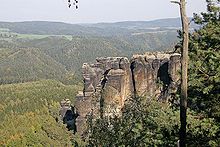Monkey stones
Coordinates: 50 ° 54 ′ 40 ″ N , 14 ° 15 ′ 20 ″ E
The Affensteine are an elongated, strongly fissured rock group of the Elbe Sandstone Mountains , which is located east of Bad Schandau in Saxon Switzerland and is in the Ostrau district . In the north they are bordered by the Kirnitzschtal , in the south by the Elbe valley and in the east by the two winter mountains. The highest point is 458 meters high, the last of Saxony Queen Carola of Vasa-Holstein-Gottorp named Carolafelsen .
hike
The Affensteine are a popular tourist destination. Numerous hiking trails with different levels of difficulty run on different levels.
The lower Affensteinweg (green point) runs on the lowest level, which is also part of the Malerweg in its fourth stage. The path is moderately steep and suitable for bicycles. Furthermore, the Königsweg (red line) runs on the lowest level as a narrow but also not steep hiking trail. This also gives you direct access to the Häntzschelstiege, a via ferrata only for the experienced.
Via various ascents, such as the wild hell, the Wolfsstiege or the Häntzschelstiege, you get to the middle level, consisting of the upper Affensteinweg (green line) and the upper Affensteinpromenade (no path markings). The wild hell is an adventurous staircase through a narrow gorge with numerous iron ladders and handles. From the upper Affensteinweg there is also direct access to the Idagrotte .
The Reitsteig (blue line), a wide forest path that connects the Schrammsteine with the large Winterberg, runs on the top level.
There is access to the Affensteine from the Kirnitzschtal as well as from the Schrammsteinen and from Schmilka .
The monkey stones surprise because of their gigantic variety of paths and vegetation.
Climb
The monkey stones are also used for climbing . The large banked and quite solid sandstone has led to the formation of many climbing peaks , on which a large part of the demanding climbing routes of the Saxon Switzerland climbing area can be found. The peaks are relatively high compared to other parts of Saxon Switzerland. The so-called Nonnenfelsen with Bloßstock , Kreuzturm and Morscher Zinne as well as other peaks such as Domwächter , Rohnspitze , Wilder Kopf , Rokokoturm , Frienstein, Hauptdrilling and the conspicuous Brosinnadel are among the most important rock towers in the area .
The climbing sport development began in 1873 with the first sporty ascent of the Frienstein. From 1890 onwards, almost all major peaks were climbed for the first time. From around 1910, the climbers began to develop increasingly difficult routes. In 1918, today's level of difficulty VIII on the Saxon scale was reached for the first time on the Wilden Kopf with the western edge .
During the time of National Socialism , active Red Mountaineers in the resistance used a cave on Satanskopf in the eastern part of the Affensteine as an illegal meeting place and to reproduce leaflets. The activities were limited to about eight weeks. Even after 1945 there were important new climbing routes on the peaks of the Affensteine. In 1958, the striking 90 meter north face of the Bloßstock was climbed for the first time . In 1965 Fritz Eske climbed a route of difficulty level IX for the first time with the Königshangel on the Frienstein. In the 1970s and 1980s, Bernd Arnold added paths in the highest levels of difficulty, such as the Wall of Evening Red (IXb) at the Nonnengärtner or Garden of Eden (Xc) at the Rococo Tower.
In the Affensteinen there is also one of the two fully developed via ferratas in Saxon Switzerland, the Häntzschelstiege .
Naming
Two variants are common for naming the monkey stones. According to a variant, the name can be traced back to the spectacular escape of a young nobleman who was imprisoned in the robbery palace at the front . According to legend, he had a tame monkey . The nobleman's servant tied a rope around the monkey's body and made him climb the steep rock at night. The young man descended and fled to Bohemia. From there the story spread to Saxon Switzerland.
The more likely explanation traces the name of the rock group back to the eagle owl that nested here. The old German word for eagle owl is Auf and the term Aufensteine has become monkey stones over the years.
Individual evidence
- ↑ 4th stage - hiking trail Malerweg Elbe Sandstone Mountains, Saxon Switzerland. From Altendorf to Neumannmühle. Retrieved on July 17, 2020 : "On the Zeughausweg and the Untere Affensteinweg you get to the Lichtenhain waterfall with the terminus of the Kirnitzschtalbahn."
- ↑ Dietmar Heinicke (general editor): Climbing Guide Saxon Switzerland. Volume 4: Affensteine, Kleiner Zschand. Sportverlag Berlin, 1990, ISBN 3-328-00439-4 , p. 13.
- ↑ Michael Bellmann: The cave guide - Elbe Sandstone Mountains. Heimatbuchverlag, Dresden 2010, ISBN 978-3-937537-21-4 , p. 341.
- ↑ elbsandsteingebirge.de
- ↑ Peter Rölke (Ed.): Hiking & Nature Guide Saxon Switzerland. Volume 1, Verlag Rölke, Dresden 1999, ISBN 3-934514-08-1 , p. 95.

